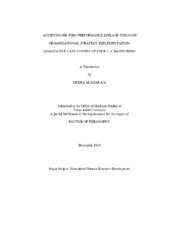| dc.contributor.advisor | Dooley, Larry | |
| dc.contributor.advisor | Egan, Toby | |
| dc.creator | Alagaraja, Meera | |
| dc.date.accessioned | 2012-02-14T22:19:12Z | |
| dc.date.accessioned | 2012-02-16T16:20:37Z | |
| dc.date.available | 2012-02-14T22:19:12Z | |
| dc.date.available | 2012-02-16T16:20:37Z | |
| dc.date.created | 2010-12 | |
| dc.date.issued | 2012-02-14 | |
| dc.date.submitted | December 2010 | |
| dc.identifier.uri | https://hdl.handle.net/1969.1/ETD-TAMU-2010-12-8867 | |
| dc.description.abstract | Several empirical studies have investigated and established the effect of HR practices and systems on organizational performance. However, there has been little or no focus on the effect of the HR function on organizational performance in both human resource development (HRD) and human resource management (HRM) literature. The term human resource development and management (HRM&D) is utilized to represent scholarly and pragmatic considerations of both fields in representing the HR function. This study elaborates on ways in which organizations achieve the HR-firm performance linkage using the resource-based view of the firm as a theoretical framework. In order to do so, the study examined HRM&D function involvement in lean and quality strategy (LQS) implementation in four U.S. based distribution companies. A qualitative case study approach was utilized to answer the following research issues: 1) the role; 2) the extent of HRM&D involvement in LQS implementation and; 3) the effect on organizational performance. A total of 51 executives participated in the study. Qualitative analysis of data using the constant comparative method helped in understanding the distinctive ways firms achieved the HRM&D-firm performance linkage. Five interrelated components are macro-conditions, strategy (LQS), structure, cross functional performance, and organizational performance affecting HRM&D involvement in LQS implementation. The results suggest that organizations leverage external and internal resources for sustaining competitive advantage, thereby enhancing organizational performance. Further, it was found that the extent of HRM&D involvement in LQS was dependent on functional engagement between the Operations and HRM&D functions. Finally, based on empirical data gathered and verification, the following results emerged: (1) three distinctive levels of cross functional performance; interactions, alignment and integration between Operations and HRM&D illustrated the manner in which HRM&D functions are utilized by organizations espousing LQS; (2) stronger HRM&D-firm performance linkages are created by socially complex relationships influenced by environment and internal factors such as leadership, culture, strategy and structure, (3) strategic relevance of the HRM&D role increased involvement in organizational strategy implementation and, (4) potential resource based advantages for HRM&D function in achieving business partner status were isolated. The implications of the study are outlined. | en |
| dc.format.mimetype | application/pdf | |
| dc.language.iso | en_US | |
| dc.subject | HRD | en |
| dc.subject | HRM | en |
| dc.subject | Organizational performance | en |
| dc.subject | strategy implementation | en |
| dc.subject | Lean and Quality strategy | en |
| dc.title | Achieving HR-Firm Performance Linkage through Organizational Strategy Implementation: Qualitative Case Studies of Four U.S. Based Firms | en |
| dc.type | Thesis | en |
| thesis.degree.department | Educational Administration and Human Resource Development | en |
| thesis.degree.discipline | Educational Human Resource Development | en |
| thesis.degree.grantor | Texas A&M University | en |
| thesis.degree.name | Doctor of Philosophy | en |
| thesis.degree.level | Doctoral | en |
| dc.contributor.committeeMember | Lawrence, Barry | |
| dc.contributor.committeeMember | Woodman, Richard | |
| dc.contributor.committeeMember | Dooley, Kim | |
| dc.type.genre | thesis | en |
| dc.type.material | text | en |


